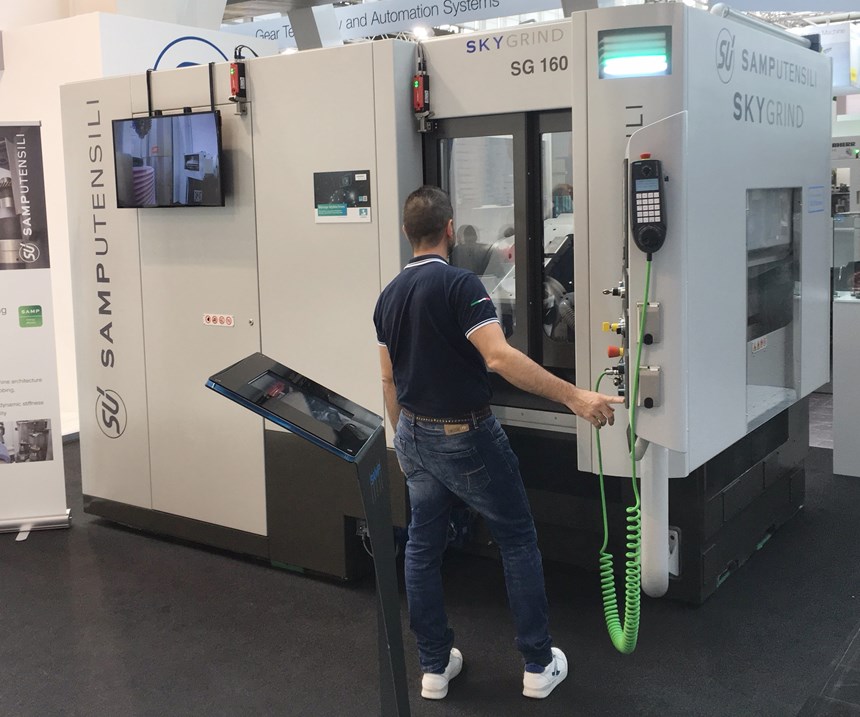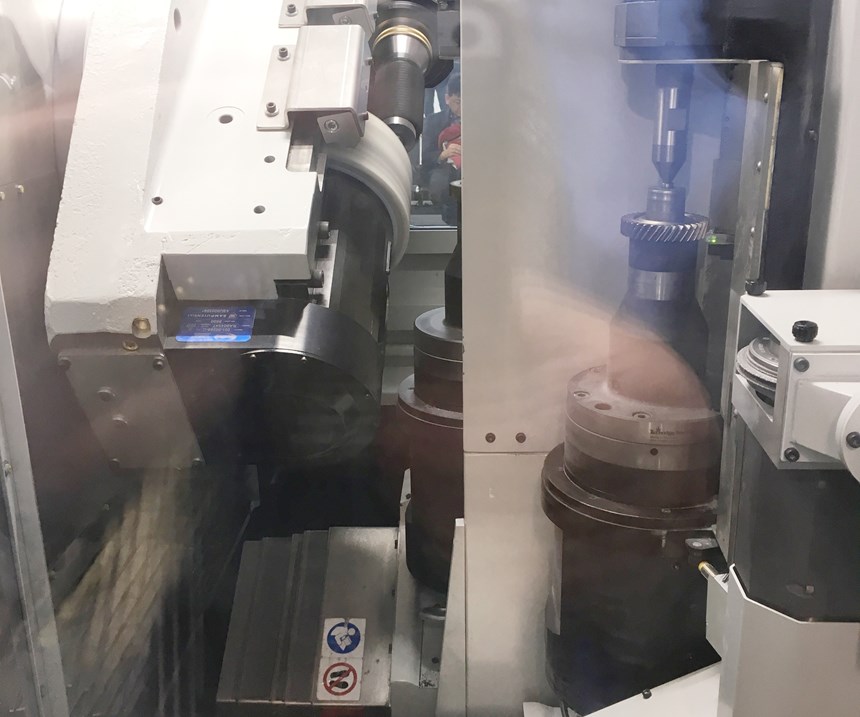How Dry Grinding Permits Coolant-Free Gear Making
Grinding the external forms of automotive gears came to be the last step still needing coolant. This machine eliminates cutting fluid by combining gear grinding with dry skiving in the same cycle.
Hans Grass, vice president of the machine tool group with Star SU, and Roberto Bagni, machine tool product manager with the company, say that a recently developed option for dry grinding the external tooth forms of automotive gears resulted from the widespread adoption of hard turning for machining a very different feature, the gears’ bore. The connection is this: Performing much of the bore’s stock removal through turning rather than grinding, with grinding left to remove only a much smaller amount of stock, enables both of these bore machining steps to run dry. That is, a heavy amount of grinding requires coolant, but hard turning plus slight grinding can do without it. This change, removing coolant from bore machining, left grinding the teeth as the last gear-machining operation still in need of a cutting fluid. If coolant could be eliminated from this step as well, then the result could be an entirely coolant-free process for high-volume gear production. Gear manufacturing equipment supplier Samputensili, which is represented in the United States by Star SU, decided that the pressure was on to develop and introduce a coolant-free gear finishing machine.
Dry grinding of gear teeth is not new; it has been performed successfully in the past. However, the problem—and the issue that makes dry grinding challenging for volume production—is the risk of heat-related damage to the teeth. The dry grinding pass must be quick and the stock removed must be minimal to prevent this damage.
Meanwhile, another established potential solution for precision gear machining without coolant is skive hobbing, Mr. Grass says, but the challenge here is that this is not quite precise enough. Skiving alone does not hold the finest tolerances automotive manufacturers require, he says. Therefore, the SG 160 Skygrind machine from Samputensili achieves dry grinding by using these technologies together. Similar to the way hard turning removes much of the bore’s material before grinding, skiving removes much of the gear teeth’s remaining material before grinding. To eliminate any imprecision resulting from handling between the two steps, the Skygrind performs dry skiving followed by light, fast, dry grinding within the same cycle on the same machine.
Mr. Bagni says that in Europe there is significant regulatory pressure to achieve more environmentally friendly manufacturing processes. That pressure alone justified the adoption of this technology by a European automotive manufacturer using it now. By contrast, in North America, he expects the potential cost savings, combined with health and safety improvements resulting from eliminating coolant, to provide ample incentive for this system’s adoption.
The cost savings come in various forms, he says. In addition to doing away with the purchase and handling costs of the coolant itself, there is also the savings in capital equipment investment from eliminating a coolant filtration system. Then there are the floor-space savings. The coolant filtration system for a high-volume grinding process can easily take up more space than the footprint of the Skygrind machine, meaning dry machining can enable the end user to fit more machine tools into a given unit of space. For these reasons, while converting a new plant to dry machining might be difficult, Mr. Bagni sees great promise that new plants built in the years to come might look to this machine to achieve entirely coolant-free gear making.
The Skygrind is built on the same platform as Samputensili’s G 160 machine, which is a novel design in itself offering various productivity advantages. In place of a rotary table carrying workpiece spindles for two parts, the machine uses two separate, parallel X axes to quickly move parts into position via linear motors, achieving part-to-part change times that are faster than a rotary table by several seconds. On the Skygrind machine, this feature contributes to dry grinding specifically because the machining cycles for dry grinding of small automotive pinions are liable to be fast. Without fast part-to-part time, the change-over between parts would account for a significant share of production time, which is not the case with this system. Meanwhile, the company notes that another feature of the machine platform contributes to a small footprint: In place of interpolating with X, Y and Z axes for the hobbing and grinding heads, the machine realizes the same motion with Y, Z and a rotary A axis. Eliminating one linear axis enables the machine to be more compact.
RELATED CONTENT
-
Custom Tooling, Workholding Help Whip Rotors Into Shape
Whipple Superchargers uses unique form tools and dead-length-collet workholding for its B-axis turn-mill enabling it to create more accurate rotors for its brand of engine power-adders.
-
How Eaton Uses Metal 3D Printing
With the ability to address customer needs faster and iterate parts quickly, this metal 3D printing system is now standard within the workflow for both the engineering and toolroom teams.
-
Advances in Swiss-Type Technology
R&D efforts in recent years have led to higher efficiencies, increased agility and expanded capabilities for shops performing Swiss-type turning.






.jpg;width=70;height=70;mode=crop)
